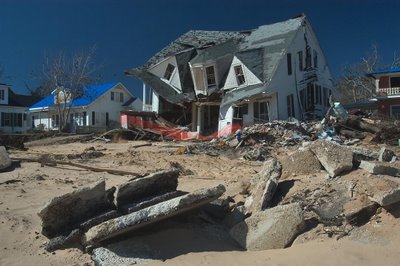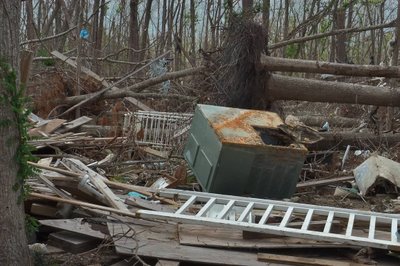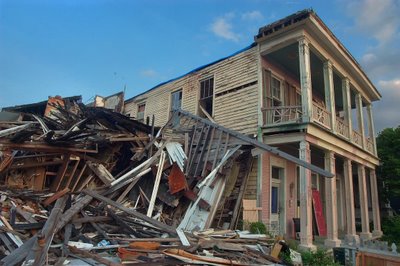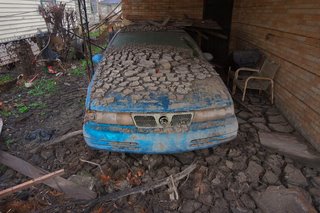Katrina Lays Bush's Guilt Bare

Click on image to enlarge.
Bay Saint Louis, MS Alexey Sergeev © February 2, 2006
Because the facts about the remaining devastation from Hurricane Katrina are so powerful, and the glaring ineptitude of the Bush Administration's handling of the disaster (to this very day) are so stark I've decided to use only two sources for today's blog. The images are from a fantastic collection of photographs by a Russian chemistry professor named Alexey Sergeev. I was unable to contact him for permission to use his remarkable images so I hope he approves of this posting. The other source is a surprisingly detailed review, by Associated Press (in USA Today), of the Bush Administration's follow-through on promises made by the President one year ago. Links to both sources are at the bottom of today's post.
NEW!! Mark Fiore's Whoopsi Gras II
A Year After Katrina, Bush
Administration Fulfills Few Promises
8/20/2006 Associated Press
Nearly half of New Orleans was still under water when President Bush stood in the Crescent City's historic Jackson Square and swore he would "do what it takes" to rebuild the communities and lives that had been laid to waste two weeks before by Hurricane Katrina.
"Our goal is to get the work done quickly," the president said.
He promised to spend federal money wisely and accountably. And he vowed to address the poverty exposed by the government's inadequate Katrina response "with bold action."
A year after the storm, the federal government has proven slow and unreliable in keeping the president's promises.
The job of clearing debris left by the storm remains unfinished, and has been plagued by accusations of fraud and price gouging. Tens of thousands of families still live in trailers or mobile homes, with no indication of when or how they will be able to obtain permanent housing. Important decisions about rebuilding and improving flood defenses have been delayed. And little if anything has been done to ensure the welfare of the poor in a rebuilt New Orleans.
How has the government performed in the most critical areas of the recovery and reconstruction effort?

Click on image to enlarge.
Biloxi, MS Alexey Sergeev © April 9, 2006
EMERGENCY ASSISTANCE: A June report by the Government Accountability Office concluded that FEMA wasted between $600 million and $1.4 billion on "improper and potentially fraudulent individual assistance payments."
Government auditors found that debit cards distributed to Katrina victims were used to pay for things like Dom Perignon champagne, New Orleans Saints season tickets and adult-oriented entertainment. The audit also found that people used fictional addresses, fake Social Security numbers and the identities of dead people to fraudulently register for assistance. FEMA also double-deposited funds in the accounts of 5,000 out of the nearly 11,000 debit card holders.
CLEANUP: The job still isn't done. More than 100 million cubic yards of debris have been cleared from the region affected by Katrina. So far the government has spent $3.6 billion, a figure that might have been considerably smaller had the contracts for debris removal been subject to competitive bidding.
Working through the U.S. Army Corps of Engineers, FEMA gave each of four companies contracts worth up to $500 million to clear hurricane debris. This spring government inspectors reported that the companies — AshBritt Inc. of Pompano Beach, Fla., Phillips and Jordan Inc. of Knoxville, Tenn., Ceres Environmental Services Inc. of Brooklyn Park, Minn. and ECC Operating Services Inc. of Burlingame, Calif. — charged the government as much as four to six times what they paid their subcontractors who actually did the work.

Click on image to enlarge.
Dead Forest, Bay Saint Louis, MS Alexey Sergeev © April 16, 2006
HOUSING: In his Jackson Square speech, Bush said his goal was to "get people out of shelters by the middle of October."
By and large that goal was met, with all but a few thousand of 270,000 Katrina evacuees out of shelters by mid-October.
But that didn't solve the monumental housing problem created by Katrina. Most of the people who had been in shelters went to hotel rooms, with FEMA picking up the bill. About 50,000 families who had evacuated to other cities were promised a year of rent assistance, though in April FEMA began cutting off some who the agency said did not qualify for the program. More than 100,000 families moved into trailers or mobile homes parked either in the yards of their damaged houses or in makeshift compounds.
Meanwhile, FEMA flailed and flip-flopped on its contracting policies for trailers, mobile homes and other temporary shelter. The first big contracts were handed out non-competitively to four well-connected companies — Shaw Group, Bechtel Corp., CH2M Hill Inc. and Fluor Corp. Then in October FEMA director R. David Paulison promised to rebid the contracts after Congress complained that smaller companies, especially local and minority-owned firms, should have a chance to compete for the work.
A month after that, FEMA said the new contracts would not be awarded until February. That deadline came and went, and then in March a FEMA official announced that the contracts weren't going to be rebid after all.
A week later FEMA reversed itself again, giving up to $3.6 billion in business to small and minority-owned firms.
"I promised Congress I was going to bid them out, and that's what I'm doing," Paulison said.

Click on image to enlarge.
New Orleans Alexey Sergeev © July 2006
REBUILDING: Despite Bush's Jackson Square promise to "undertake a close partnership with the states of Louisiana and Mississippi, the city of New Orleans and other Gulf Coast cities," state and local officials had a hard time reaching a deal for federal aid to help residents rebuild their ruined homes.
In January the administration rejected a $30 billion plan for Louisiana as too expensive. The White House also balked at subsidizing the reconstruction of homes in flood plains, a policy that would have excluded all but a small fraction of Louisiana homeowners whose houses were significantly damaged.
The state finally won funding in July for the $9 billion 'Road Home' program, which pays homeowners up to $150,000 either to repair their damaged property or rebuild elsewhere in the state. People who leave the state are eligible for a 60% buyout. The money, which is being distributed through escrow accounts to prevent fraud, is just becoming available a year after the hurricane.

Click on image to enlarge.
9th Ward New Orleans Alexey Sergeev © February 2, 2006
LEVEES: The federal government hasn't broken any promises with regard to flood protection — mostly because it has assiduously avoided making any.
White House Katrina recovery czar Donald Powell has said that the administration intends to wait for the completion of a $20 million U.S. Army Corps of Engineers study, due in December 2007, before it decides whether to enhance the flood protection system in southern Louisiana enough to resist a Category 5 hurricane.
A preliminary draft of the study released in July was widely criticized because it omitted five projects that state officials say should be started right away. At the same time, it focused on a massive levee that would stretch hundreds of miles along the Louisiana coast while paying only lip service to the critical task of shoring up the state's vanishing wetlands, which provide a natural barrier to hurricane flooding.
"We're wasting our time and money and attention contemplating large-scale levees across the entire state," said Tim Searchinger, an attorney with the advocacy group Environmental Defense.
The federal government has committed about $6 billion since Katrina to repair and improve the Big Easy's existing levee system. The first goal was to bring the levee system back to "pre-Katrina" levels by the beginning of the 2006 hurricane season on June 1. That goal was largely achieved. The next step will be to make improvements that will bring the system up to what is variously called Category 3 or 100-year protection by 2010.
But planners and state and local officials say that the levees need to be brought up to Category 5 protection, a level that would cost up to $30 billion, if people are to have confidence moving back to areas destroyed by Hurricane Katrina.

Click on image to enlarge.
Plaquemines New Orleans Alexey Sergeev © February 5, 2006
POVERTY: Bush offered three proposals in Jackson Square to help combat poverty around the Gulf Coast region. Two of them never went anywhere — the creation of "worker recovery accounts" that would help evacuees find work by paying for school, job training or child care while they looked for employment, and an Urban Homesteading Act that would give poor people building sites for new homes that they would either finance themselves or obtain through programs such as Habitat for Humanity.
A third proposal, the creation of a Gulf Opportunity zone, did come to pass. Signed by President Bush in December, the legislation gives $8.7 billion in tax breaks to developers of low-income housing projects, small businesses and individuals affected not just by Katrina but by hurricanes Rita and Wilma as well. The law also provides debt restructuring for financially troubled local governments in the area.
Alexey Sergeev's
2006 Photos
Full Associated Press Story
How protect the Gulf Coast for the future.
Please respect the work of the artists you see here and be sure to credit them when you share their artwork with others.
To share your opinion on this or any other post, please click the word "COMMENTS" below.




0 Comments:
Post a Comment
<< Home